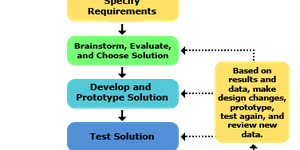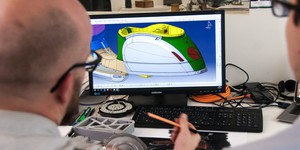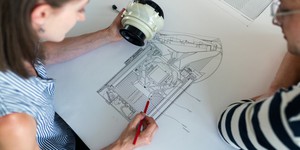Summary
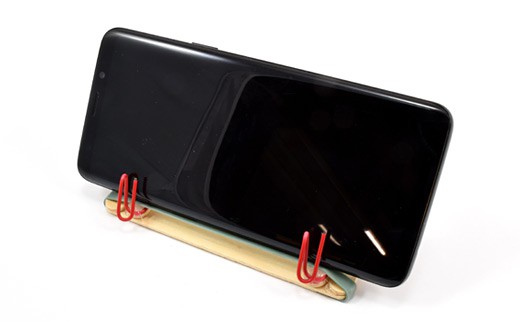
Introduction
Why buy it when you can build it? That is the attitude you will need for this project. You have probably seen cell phone holders or stands around the house or in a car. They might seem like a very simple object, but they are a great way to learn about the engineering design process. In this project, you will design and build your own working phone stand.Materials
Since this is an engineering design project, there is no exact list of materials you need to use. Here are some suggestions to get you started:
- Cell phone or tablet. If you do not have a real phone available, you can make a substitute phone (see Prep Work section).
- Structural materials, like corrugated cardboard or wooden craft sticks
- Tape or glue
- Other assorted office/craft supplies like rubber bands, paper clips, binder clips, pipe cleaners, etc.
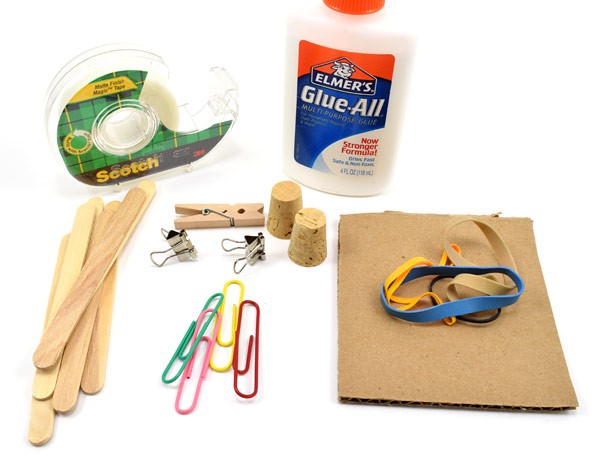 Image Credit: Ben Finio, Science Buddies / Science Buddies
Image Credit: Ben Finio, Science Buddies / Science Buddies
Prep Work
Instructions
- Before you can start to design something, you will have to define exactly what problem you are trying to solve. For example, "I need to be able to see my phone's screen to use GPS while I am driving," or "I want to prop up my tablet to watch a movie without having to hold it." The best solutions to these different problems probably will not be the same. Figure out exactly what problem you are trying to solve before you continue. In other words, why do you need a phone stand? How will you use it?
- Do some background research. If you have internet access, look around online at designs for different types of cell phone stands.Are there different kinds? How are they different? Do they all serve the same purpose?
- Specify requirements for your phone stand. These requirements will depend on how you plan to use the stand. For example, do you need it to work for devices of different sizes, or just one? Do you want the angle of the phone to be adjustable? Do you need to make sure certain buttons or ports on the phone remain accessible? Do you need to be able to type or push buttons on the screen without knocking it over?
- Brainstorm some designs for your phone stand. Make sketches of them on paper and write down the materials you would need to build them. Try to come up with at least three different designs, then think about how they would meet your requirements. Your designs do not have to look like the example in this project; you can do something totally different!Which one do you think will meet the requirements the best?
- Build a prototype of your best design. You might need to start adjusting your design at this point! For example, maybe the parts do not fit together like you thought they would. If you run into problems when building your prototype, it is OK to modify the design, or even switch to a completely different design if you realize it will not work as intended. This picture shows a prototype made from wooden craft sticks, rubber bands, and paper clips, held together with glue. The craft sticks provide the frame, the paper clips hold up the phone, and the rubber bands provided added friction to prevent the stand from sliding around.
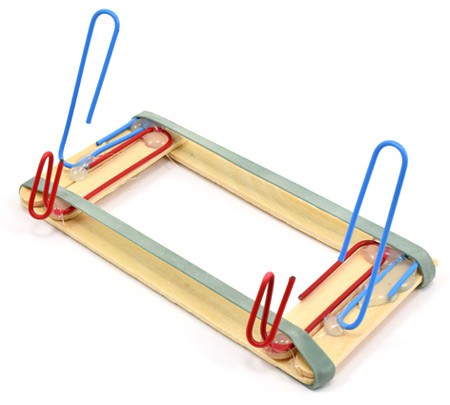 Image Credit: Ben Finio, Science Buddies / Science Buddies
Image Credit: Ben Finio, Science Buddies / Science Buddies
- Test your prototype! Try using it yourself or giving it to someone else to try out, and go through various real-world usage scenarios. For example, can you plug in the phone's charging cable? If you push on the screen, does it fall over? You could even try dropping the stand (take out the phone first!) to see if it breaks.Does your prototype meet all of your requirements?
- If not, then it is back to the drawing board—time to iterate and make changes to your design. Keep iterating until your phone stand meets all your requirements.
Cleanup
What Happened?
Did your phone stand work perfectly on the first try? You might have thought you had a perfect design on paper, and then been surprised to find out it did not work as intended. Maybe there was not enough friction between your stand and the table, so it slid around too easily. Maybe it was too narrow and fell over when you put the phone in, or maybe the materials you used were not stiff enough and sagged under the weight of the phone. There are plenty of things that could have gone wrong—but that is why you built a prototype and tested it first! That gave you a chance to make changes to your design to make sure it met all your requirements.
Engineers do the same thing—you would not want to design a product, start selling it, and then find out it does not work properly. That could result in your company losing a lot of money, or worst case, result in people getting seriously injured or killed (e.g. for products like cars, or electrical appliances that could catch fire). Engineers almost always build and test prototypes before launching a final product. Now that you are familiar with the engineering design process, what will you design next?
Digging Deeper
Look around you. You are probably surrounded by tons of everyday objects, like your cell phone stand, that do not seem very "scientific." Desks, chairs, lamps, doors, pencil holders, etc. However, many of these objects were probably designed by engineers, who had to figure out things like what materials to make them out of, how much weight they would need to support, and how to manufacture them. If the engineers do their jobs well, you might never notice. But you would certainly notice if the chair you were sitting in fell apart or the light switch did not work!
Engineers design things using the engineering design process, which is different from the scientific method. The exact steps of this process may vary a bit depending on who you ask, but they generally go something like this:
- Define the problem
- Do background research
- Specify requirements
- Brainstorm solutions
- Build a prototype
- Test the prototype
- Iterate
What does "iterate" mean? It means you might do some of the steps more than once! Things rarely work perfectly on the first try. You might think you have the perfect design for something, then test it and find out it does not work at all—so it is back to the drawing board! That is probably what you experienced with your cell phone stand.
Ask an Expert
For Further Exploration
- Even if your phone stand meets all your initial requirements, you can still try to improve it. For example, can you make a stand with equivalent performance using fewer materials? In the real world, this would save on manufacturing costs.

